Main Body
Chapter 6: Functional Analysis Case Training
Abstract: This chapter describes a plan to guide teaching functional analysis skills in a comprehensive manner through role play, case-based teaching, and performance-based training methods. This exercise, with content material based on actual research cases, is designed to teach the process and implementation of functional analysis for use in classrooms, in-service training, and workshops.
Focus Questions:
- How can functional analysis best be taught?
- What are the components that need to be taught in the functional assessment process as a whole?
- What is FACT and how does it differ from previous approaches to teaching functional assessment?
A Plan to Teach the Process of Performing a Functional Assessment
FA is a complex subject that requires an extensive knowledge-base, clinical decision-making skills, and performance components. In Chapter 2 the different types of FAs were described. In Chapter 3 treatment procedures were covered. Chapter 4 reviewed instructional approaches to establish students’ knowledge and clinical decision-making skills. Lastly, Chapter 5 addressed how performance-based training could be used to teach the skills involved with conducting functional analysis. The focus of this chapter is to provide a method to practice the process of FA and the multiple steps that comprise it. See Table 21 below for a list of the steps involved in conducting a FA.
To conduct a functional assessment the professional must:
|
Comprehensively Teaching the Functional Assessment Process
Descriptions in the research literature of efforts to teach a comprehensive set of practitioner skills have been few. One early demonstration of a comprehensive training program to teach undergraduate psychology students to provide clinical or in-home consultative services was described by Keeley, Shemberg, and Ferber (1973). This training program involved: (a) content and practice in observing and recording behavior, (b) interventions, and (c) professional and ethical skills. The instructional approach involved lectures, role plays, and problem-solving client cases. The authors report positive results of this program to teach 37 senior-level psychology students how to deliver services to individuals with developmental disabilities and their families; however, no systematic evaluation of the program was performed.
In a more recent research evaluation of a comprehensive therapist training program, Chok, Shlesinger, Studer, and Bird (2012) describe a curriculum that involves teaching four components including: (a) conducting FAn sessions, (b) interpreting graphs, (c) responding to undifferentiated data, and (d) designing treatments. Participants completed assignments and were provided with feedback for answers along with the other knowledge components until mastery was achieved. Training was tailored to the component taught with performance feedback provided to participants when conducting FAn conditions. The researchers used a concurrent multiple-baseline design across participants to evaluate the training program. Participants acquired the skills at a near-perfect accuracy with generalization across training stimuli and 3 month maintenance occurring. Some limitations noted in this study were that participants’ application of procedures to actual client behaviors was not assessed. Additionally, the gamut of clinical skills were not addressed, such as ethical issues, defining target behavior, and identifying a measurement system. Nonetheless, Chok et al.’s (2012) study provides a good example of how a systematic and comprehensive method can be used to teach the complex conglomeration of skills necessary for professionals to apply a FA method.
A New Proposed Instructional Approach: Functional Analysis Case-based Training (FACT)
Functional analysis case-based training (FACT) may be an effective method to teach a comprehensive set of skills required to perform functional analysis (Desrochers, 2012). A FACT method incorporates a case-based learning approach, role play, simulation, and performance-based feedback as major instructional methodologies to establish and hone college students’ knowledge-base and skills required to implement a FA process. Students are given brief descriptions of cases described in published research to draw upon for realistic and clinically validated approaches to solving an individual’s challenging behavior. Based on primary source material, effective assessment methods and intervention outcomes can be identified and reviewed as a group exercise. Both performing the functional analysis conditions, using role play, and employing the decision-making skills to arrive at an effective behavior intervention plan are practiced by the student in simulated clinically-relevant situations with empirically-validated results.
FACT Components
The major FACT instructional components embedded in this learning activity include students working collaboratively to solve and re-enact problem situations for individuals in clinical/school/home settings. The case examples are drawn from published research to provide realistic characteristics of individuals and their assessment and treatment data.
Team-work
This exercise is a collaborative learning, team-based approach. Working in separate groups of three, college students are asked to assume key roles such as client/student, therapist/teacher, or director. The other groups serve as actively participating audience members during the presentation of each group’s case.
Skills that are interpreted, simulated, or acted out in a role play include: (a) behaviorally defining the individual’s challenging behavior; (b) identifying the function of the individual’s challenging behavior (c) conducting the conditions for a FAn; (d) analyzing graphical presentations of behavior; and (e) identifying function-based treatments for that case. Once the scenarios have been practiced, teams present their case to other students/audience members who must complete the following tasks: (a) behaviorally defining the challenging behavior; (b) determining how to assess and record the challenging behavior during the various functional analysis conditions; (c) analyzing the function of the client’s challenging behavior; (d) determining the most effective treatment based on that function of the challenging behavior; and (e) reviewing the ethical issues that may exist in the situation presented. Feedback concerning audience members’ answers to questions is provided by the trainer/director presenting the case.
| Role | Duties |
| Student/Client | Realistic presentation of problem behavior under various conditions to simulate the graphed data |
| Teacher/Therapist | Accurate presentation of procedures for each functional analysis condition: attention, demand, tangible, alone, play |
| Director/Trainer
|
Part I: Provide immediate performance feedback concerning client and therapist behaviors using the behavior integrity checklist
Part II: Provide audience with the context for the case (e.g., age of client, setting, etc.) Present questions and provide feedback to the audience to facilitate active engagement in the case, such as:
|
| Audience
|
Be able to:
|
In this role play situation the audience is actively involved and practicing many of the decision-making skills involved in the FA process. The audience is asked by the director of the performing group to respond to key features of the case by: (a) defining the challenging behavior; (b) determining the measurement approach (i.e., frequency, duration, etc.); (c) recording levels of the problem behavior in various conditions (attention, demands, tangible, alone, play); (d) identifying the maintaining variable for the individual’s challenging behavior; and (e) designing effective interventions to decrease the challenging behavior based on the function of the challenging behavior and ethical considerations. The director provides immediate feedback for the audience’s answers in each of these topic areas.
Programming for Generalization of Functional Assessment Knowledge and Skills
This interactive exercise allows students to practice performing most of the steps involved in completing the FAn (see Chapter 2) and the overall FA process such as review of client case, administration of functional analysis, interpretation of data, designing effective intervention. Furthermore, use of multiple case scenarios (based on general case strategy) representing multiple perspectives (e.g., audience, and role playing a therapist, client, or director) may facilitate college students’ generalization of skills beyond the boundaries of the training cases presented (Moore & Fisher, 2007).
Summary
The process of FA is complex and so instructional methods to teach it must incorporate multiple strategies to ensure adequate coverage of this topic to thoroughly teach it. A FACT method is one step toward a comprehensive approach to teaching pre-professionals how to effectively assess and treat the challenging behaviors of individuals with developmental disabilities.
FACT Hand-Outs for Students
Purpose of the Activity:
- To provide you with invaluable hands-on experience with an assessment/treatment approach that has been experimentally-validated for use with a variety of populations and problems.
- To provide you with the tools that will be useful to you in your career.
- To provide you with the skills and knowledge that potential employers seek!
Instructions:
- You and your group members should first carefully read your selected research article and summarize the main points. Pay close attention to the client’s behavior, procedure, and results of the functional analysis conditions. Review those areas with your group members once everyone has read the article or its summary.
- Assign roles (alternate roles so that everyone has an opportunity to perform each role) including client, researcher/practitioner, and trainer.
- Client Role: Read the participant description section of the article you are assigned and simulate the behaviors that are described. Scrutinize the graphical presentations of the data and be prepared to approximately portray those levels of the client’s behavior in each condition (e.g., demands, alone, attention, etc.).
- Teacher/Therapist Role: Read and review the procedure for each functional analysis condition. You will be implementing that procedure with your simulated client and collecting data on that person’s behavior.
- Director/Trainer Role: Your duties are to describe the client to your “audience,” announce conditions, score the researcher’s behavior and provide performance-based feedback to your researcher/practitioner evaluating his/her completion of the steps involved in completing each FAn condition.
3. Practice conducting the functional assessment with performance-based feedback.
- Director/Trainer introduces the problem situation and describes the client and the setting.
- Teacher/Therapist conducts the brief sessions and collects data on the client’s behavior.
- Director/Trainer announces the condition and collects data regarding researcher’s/practitioner’s performance.
- For each functional analysis condition (conduct it for only 5 min maximum), the client and Teacher/Therapist simulate the process.
- Review the procedures to conduct the condition. Conduct the condition. At the end of simulated experience trainer provides constructive feedback to Teacher/Therapist (i.e., praise aspects of the procedure done well and indicate areas needing improvement). If needed (<80% correct procedural performance), rehearse again.
- Reflect and evaluate your performance as to whether you engaged in all steps required to conduct FA. Some research suggests that self-reflection can enhance one’s performance (Fallon, Ackley, & Brown, 2003).
For instructional purposes, perform the functional analysis live in-class or video-taped for your classmates! Your audience will be required to “collect data” as you perform the conditions using the checklist for determining treatment fidelity (see below) and so be sure to make the conditions in keeping with the data and as realistic as possible.
Activity developed by M. Desrochers (2010). The College at Brockport-SUNY
Experimental Functional Analysis Procedural Description and Reliability Checklist
A functional analysis is performed to experimentally identify the maintaining variable for the individual’s problem behavior. This exercise is designed to maximize your acquisition of how to perform this assessment approach.
- Behaviorally define the problem/target behavior.
- Identify the recording procedure used to measure the client’s problem behavior.
- Indicate the ethical issues that may be present when conducting a functional analysis and state how each issue will be addressed.
A FAn is typically conducted using a multielement research design (i.e., alternating treatment design), involving concurrently presenting two or more conditions on the same day (Martin & Pear, 2011). All conditions are presented for at least 5 min on an assessment day, with a brief 5-min break between them. The order of conditions is alternated across days (e.g., Day 1: attention, demands, alone, play; Day 2: demands, alone, play, attention, etc.). At least 4-5 data points are collected so that trends and levels of the problem behavior across conditions can be determined. Graphed data are examined to identify differential levels of the individual’s behavior across conditions.
For the purposes of this role play simply demonstrating a single session for each condition will suffice. Inform your audience that this session is representative of the client’s average responses that occurred across multiple sessions.
Review the description, purpose, and procedure for each functional analysis condition described. Then, in your small group: (a) review the client case together; (b) assign roles (i.e., client, therapist, director); (c) plan how to represent the case; and (d) practice performing the conditions that simulate the client’s level of problem behavior as depicted in the graph until mastery performance is achieved in conducting the functional analysis conditions.
Activity developed by M. Desrochers (2010). The College at Brockport-SUNY
Attention Condition
These are the standard experimental functional analysis conditions as described by Iwata, et al., 1994/1982, JABA, 27, 197-209 and Iwata et al., 2000.
Description & Rationale:
The purpose of this condition is to determine if the individual’s problem behavior is due to attention positive reinforcement. Under conditions of social deprivation and in the presence of one or two adults, eye contact, physical contact, reprimands, or verbal interaction may be contributing to the individual’s problem behavior. The therapist presents verbal statements, such as “No, don’t do that” or similar comments that typically are given by others in the individual’s natural environment immediately after the individual’s problem behavior. Although it may seem counter-intuitive, even telling the individual not to do something may increase the likelihood that the behavior occurs or serves as a positive reinforcer! Note that this condition may be tailored to the specific stimuli found to correlate with the occurrence of the individual’s problem behavior based on descriptive and observational functional assessments. Attention positive reinforcement is when social reinforcers are delivered (e.g., verbal, eye contact, gestures) immediately after the behavior and the behavior is more likely to occur in similar future situations (Martin & Pear, 2011).
If the individual’s problem behavior is worse under the attention condition compared to other conditions or the control conditions then this result suggests that attention positive reinforcement is maintaining their behavior.
Procedure:
Set the timer and begin. The therapist tells the client to play with toys and then ignores the child (i.e., no verbal interaction, eye contact, nor any other consistent reaction to the child’s behavior). The therapist ignores the child’s appropriate behavior or inappropriate behavior that is not the target behavior. The therapist can be reading a magazine or talking to another adult. If the child engages in the problem behavior, then the therapist provides attention (e.g., eye contact and “Please do not do that, you are going to hurt yourself”) and physical contact (e.g., hand on shoulder) for 3 s. All occurrences of the client’s behavior are recorded by the therapist.
| Purpose | Summary of attention condition | |
| Social positive reinforcement | 2 adults talking/
Adult reading magazine |
R+ → Ø
R- → Attention |
Note: R+ = desirable behavior; R- = problem behavior; Ø = no response
An example of what the client’s graphed levels of the problem behavior that is being maintained by attention positive reinforcement is as follows:

As can be seen in the graph, frequency of the client’s aggressive behavior is greater in the attention condition compared to the demands and play conditions. This provides experimental evidence that the client’s problem behavior is being maintained by attention positive reinforcement.
Treatment Integrity Checklist—Attention Condition
Instructions: This checklist may be used for training purposes and for determining treatment fidelity in implementation of the attention functional analysis condition. Place a √ in the box beside the relevant procedural step if the therapist performed it correctly; an X if incorrect; or an (an omission or no response) if the procedural step did not occur at all when it should have.
Client: _____________________________________
Therapist: __________________________________
Date: ______________________________________
Session time began: ___________________________
Ended: _____________________________________
Instruction presented: _________________________
Problem behavior defined: _____________________
While the therapist is reading a magazine or talking with another adult, was the following done?
- Client told to play with toys or engage in some activity
- Client’s appropriate behavior ignored
- Client’s inappropriate behavior ignored
- Social attention and physical contact delivered to client when target behavior occurred
- Behavior outcome recorded on the data sheet
- 5 min duration of session
Notes:
__________________________________________________________________________
__________________________________________________________________________
__________________________________________________________________________
Performance-based feedback
Steps performed well:
__________________________________________________________________________
__________________________________________________________________________
__________________________________________________________________________
Steps that need correction:
__________________________________________________________________________
__________________________________________________________________________
__________________________________________________________________________
Demand (Escape) Condition
These are the standard experimental functional analysis conditions as described by Iwata, et al., 1994/1982, JABA, 27, 197-209 and Iwata et al., 2000.
Description and Rationale:
The purpose of the demand condition is to determine if the individual’s problem behavior is due to escape/avoidance of task demands or activities (AKA negative reinforcement). A negative reinforcer (escape) is when an unpleasant stimulus is present and an instance of the problem behavior removes that stimulus (Martin & Pear, 2011). The probability of an individual’s behavior that results in a negative reinforcer increases in similar future situations. Avoidance is when a threat of presentation of an aversive stimulus is present and an instance of the behavior removes that threat. Across the functional analysis conditions, if the individual’s problem behavior is worse when the demand condition is in effect compared to that in the other conditions then the problem behavior may be maintained by negative reinforcement.
Procedure:
Set timer and begin. The therapist, on repeated trials throughout the 5-min session, presents an activity or instruction to complete a task that the individual has in the past (based on interview or observational data) had difficulty in completing even when physically guided to do so.
Specifically, the therapist and client are seated at a table and the therapist presents an instruction to complete a task. The therapist waits for 5 s for the client to initiate a response.
If no response occurs to this first instruction then the therapist: (a) repeats the instruction; (b) models or demonstrates the correct response; and (c) waits 5 s for a response by the client = LEVEL 1 PROMPT
If no response occurs after the second instruction, then the therapist: (a) repeats the instruction; (b) physically guides the client through the response using the least amount of guidance required = LEVEL 2 PROMPT
If the client emits a correct response, prompted or unprompted, the therapist provides praise (“Nice work”).
If the client engages in the problem behavior at any time, then the therapist immediately turns away from the client for 30 s, with additional 30 s for any repeated instances of the problem behavior.
| Purpose | Summary of Demand Condition | |
| Negative reinforcement | Present requests to complete a task | R+ = praise
X/Ø = prompt, level 1 & 2 prompts R- = removal of task |
Note: R+ = desirable behavior; R- = problem behavior; Ø = no response, X = incorrect
An example of what the client’s graphed levels of the problem behavior that is being maintained by negative reinforcement (specifically, escape from task demands) is as follows:
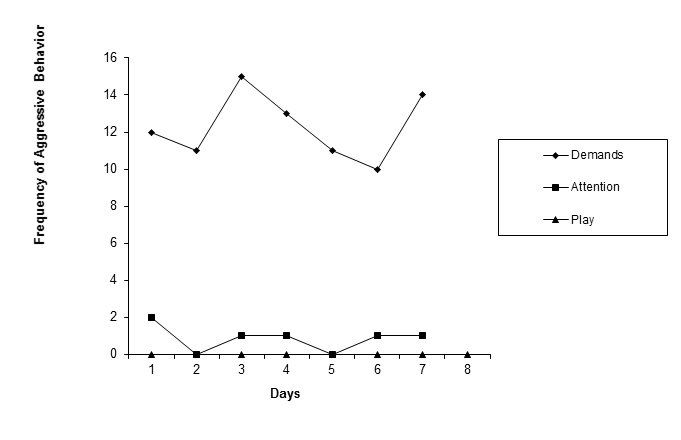
As can be seen in the graph, frequency of the client’s aggressive behavior is higher in the demands condition compared to the attention and play conditions. This provides experimental evidence that the client’s problem behavior is being maintained by negative reinforcement.
Treatment Integrity Checklist—Demand Condition
Instructions: This checklist may be used for training purposes and for determining treatment fidelity in implementation of functional analysis conditions. Place a √ beside the relevant procedural step if correct; an X if incorrect; or an Ø (an omission or no response) if it did not occur at all when it should have.
Client: _____________________________________
Therapist: __________________________________
Date: ______________________________________
Session time began: ___________________________
Ended: _____________________________________
Instruction presented: _________________________
Problem behavior defined: _____________________
- Instruction by therapist presented correctly.
If √:
- Praise delivered following client’s correct response, prompted or unprompted.
If X/Ø:
- Training trials continued (i.e., no pause) when client emits any other behavior than target after instruction.
- Therapist presents 2nd level prompt (repeat instruction and demonstrate) following client X/Ø.
- Therapist presents 3rd level prompt (repeat instruction and physical guidance) following client’s X/Ø response.
- Praise delivered after client’s √ response.
If problem behavior:
- Therapist ignores or turns away following client’s problem behavior for 30 s.
- Begin a new trial when the 30-s interval has ended.
- Behavior recorded correctly on each trial—√, X/Ø, R—, P (prompt), U (unprompted).
- 5 min duration of session.
Notes
__________________________________________________________________________
__________________________________________________________________________
__________________________________________________________________________
Performance-based feedback
Steps performed well:
__________________________________________________________________________
__________________________________________________________________________
__________________________________________________________________________
Steps that need correction:
__________________________________________________________________________
__________________________________________________________________________
__________________________________________________________________________
Play Condition
These are the standard experimental functional analysis conditions as described by Iwata, et al., 1994/1982, JABA, 27, 197-209 and Iwata et al., 2000.
Purpose and Rationale:
In the play condition, toys or activities are presented and the therapist interacts socially with the client. This condition serves as a comparison condition to rule out confounding variables or that the problem behavior is due to variables present in the attention, tangible, or demand conditions (e.g., the presence of the therapist, materials, social interaction). The amount of the client’s problem behavior in the play condition is compared to that in the other conditions. For example, if across experimental sessions the client’s problem behavior is consistently better in the play condition compared to that in the attention condition, then attention positive reinforcement may be maintaining the client’s problem behavior.
Procedure:
The therapist and client are in a room with a variety of toys present. The therapist is within 3-5 ft of the client and occasionally presents toys, with no demands. The therapist provides social praise and brief physical contact contingent on appropriate behavior at least once every 30 s. Any problem behavior is ignored unless the severity is of concern due to physical harm.
Summary
| Purpose | Summary of Play Condition | |
| Control condition | Therapist + toys | R+ → Attention
R- → Ignore |
Treatment Integrity Checklist—Play Condition
Client: _____________________________________
Therapist: __________________________________
Date: ______________________________________
Session time began: ___________________________
Ended: _____________________________________
Instruction presented: _________________________
Problem behavior defined: _____________________
Instructions: This checklist may be used for training purposes and for determining treatment fidelity in implementation of functional analysis conditions. Place a √ beside the relevant procedural step if correct; an X if not; or an Ø if it did not occur at all when it should have.
- Toys presented
- Attention provided at least once every 30 s
- Social interaction with therapist after appropriate client behavior
- No attention after client’s inappropriate behavior
- Problem behavior recorded
- 5 min session duration
Notes:
__________________________________________________________________________
__________________________________________________________________________
__________________________________________________________________________
Performance-based feedback
Steps performed well:
__________________________________________________________________________
__________________________________________________________________________
__________________________________________________________________________
Steps that need correction:
__________________________________________________________________________
__________________________________________________________________________
__________________________________________________________________________
Alone Condition
These are the standard experimental functional analysis conditions as described by Iwata, et al., 1994/1982, JABA, 27, 197-209 and Iwata et al., 2000.
Purpose & Rationale:
In the alone condition, the client is in a room by him/herself with no toys or activities (Note all safety concerns should be addressed and appropriate precautions taken). The therapist observes the client’s behavior for the purpose of data collection from a one-way mirror or video camera. This condition tests whether self-stimulation or automatic reinforcement is maintaining the client’s problem behavior by creating a situation in which low levels of stimulation exist and measuring whether the problem behavior occurs. If levels of the client’s problem behavior are worse in the alone condition compared to the other functional analysis conditions or do not differ across all conditions then automatic reinforcement may be maintaining the client’s problem behavior.
Procedure:
The client is placed in the therapy room alone, without any toys or materials that would provide a source of stimulation. The client’s problem behavior is measured.
| Purpose | Summary of Condition |
| Automatic positive reinforcement | Alone, no toys or materials |
Examples of client’s graphed levels of the problem behavior maintained by automatic positive reinforcement.
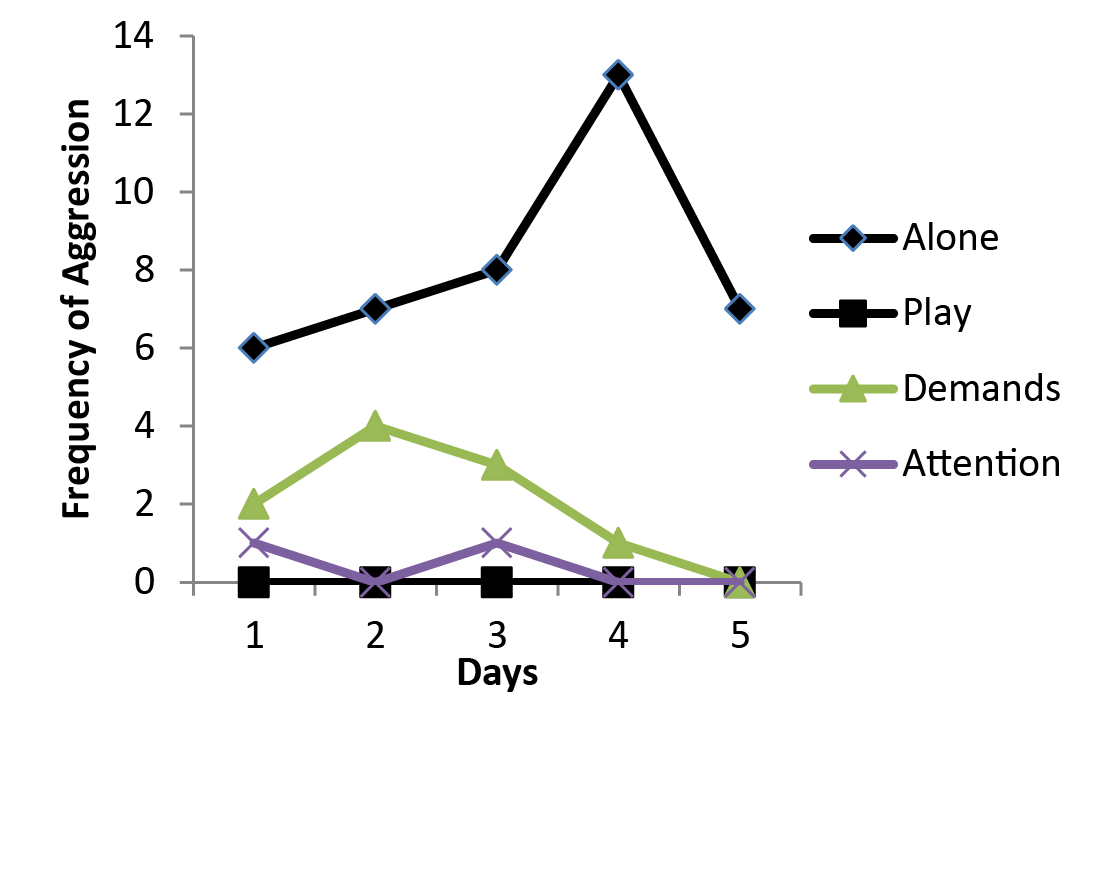
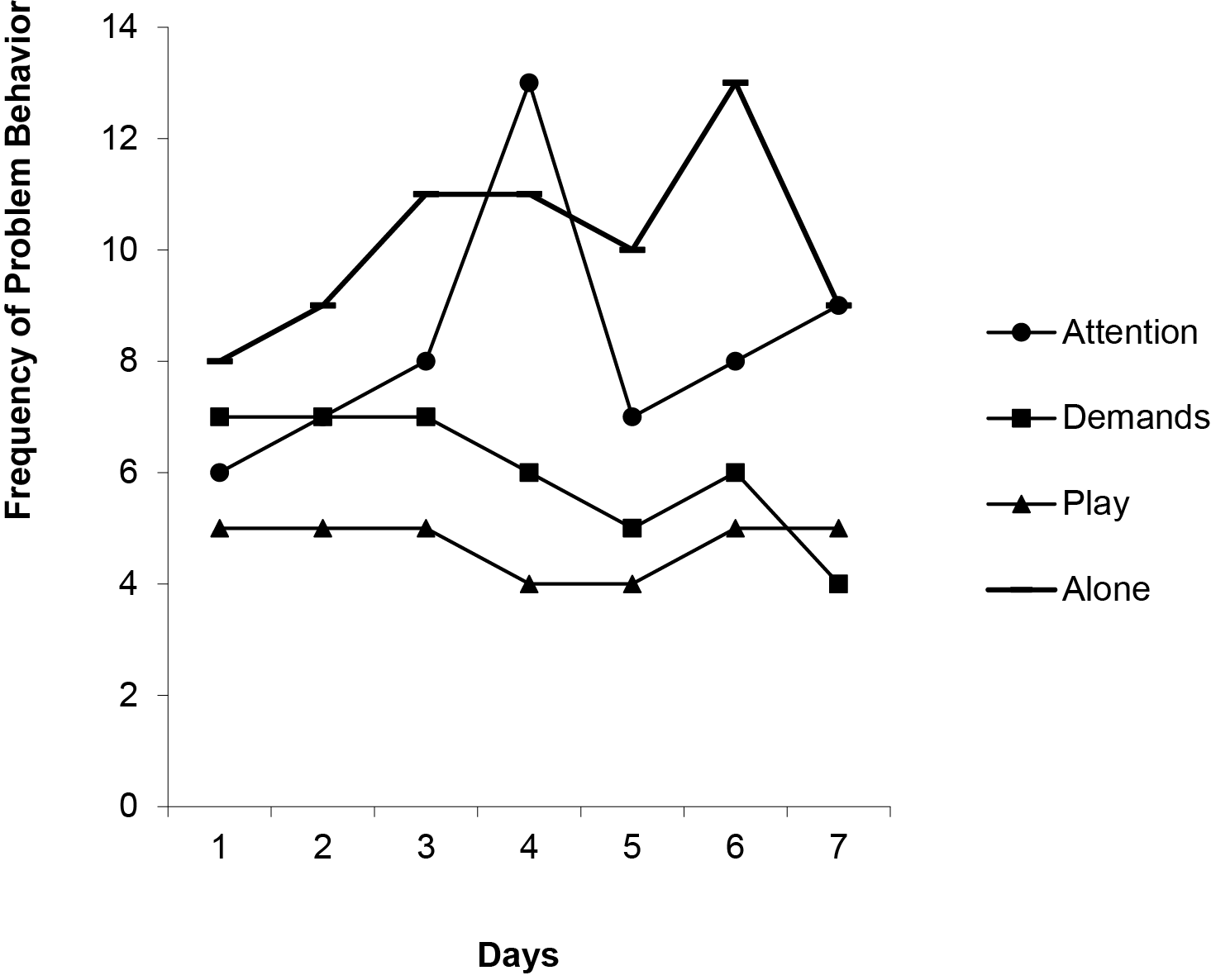
As can be seen in the above graphs, frequency of the client’s behavior is either greater in the alone condition compared to the attention, demands, and play conditions (A) or high in all conditions (B). These data configurations provide evidence that the client’s problem behavior is being maintained by automatic positive reinforcement.
Treatment Integrity Checklist—Alone Condition
Client: _____________________________________
Therapist: __________________________________
Date: ______________________________________
Session time began: ___________________________
Ended: _____________________________________
Instruction presented: _________________________
Problem behavior defined: _____________________
Instructions: This checklist may be used for training purposes and for determining treatment fidelity in implementation of functional analysis conditions. Place a √ beside the relevant procedural step if correct; an X if incorrect; or an Ø if it did not occur at all when it should have.
- Individual is alone in a room
- No toys or materials are present
- Problem behavior is recorded
- 5 min session duration
Notes:
__________________________________________________________________________
__________________________________________________________________________
__________________________________________________________________________
Performance-based feedback
Steps performed well:
__________________________________________________________________________
__________________________________________________________________________
__________________________________________________________________________
Steps that need correction:
__________________________________________________________________________
__________________________________________________________________________
__________________________________________________________________________
FACT Exercises
The following are 7 cases that can be used as the basis for FACT with students working in groups of 3 to simulate the case and practice performing the functional analysis conditions.
Brief Case Descriptions
- The Case of the Cough!: A 4-year-old who coughs during meals at home due to attention positive reinforcement
- The Case of the Delusional Statements: A 27-year-old male who engages in delusional statements at his vocational rehabilitation site due to attention positive reinforcement
- A Case in the Classroom: A 9-year-old boy who yells in the classroom due to negative reinforcement
- The Case of “You Already Said That!”: A 24-year-old man with perseverative speech due to attention positive reinforcement
- The Case of #@&*!: An 89-year-old woman with disruptive vocalization due to negative reinforcement
- The Case of Bye, Bye, I am Gone!: A 12-year-old boy who elopes due to attention positive reinforcement
- The Case of Hair Today, Gone Tomorrow: A 19-year-old female who manipulates and pulls her hair due to automatic reinforcement
The Case of the Cough!
Watson, T. S., & Sterling, H. E. (1998). Brief functional analysis and treatment of a vocal tic. Journal of Applied Behavior Analysis, 31, 471-474.
Client Description & Background: Vivian, a 4-year-old typically developing girl who presented with a 4 month occurrence of a vocal tic in the form of repeated coughing. Just before originally exhibiting the cough, she had a respiratory infection that had since cleared up. She had been seen by her pediatrician who did not find a medical cause for her behavior. Vivian’s parents stated that her cough “was ‘annoying’ and ‘intrusive’ in their conversations” (Watson & Sterling, 1998, p.471). Her coughing generally only occurred during meals.
Definition: “loud barking or metallic sound coming from the mouth” (Watson & Sterling, 1998, p. 471).
Parent Interview Questions:
- When does the behavior occur?
- What are your reactions to the coughing behavior?
- What other times or places that the cough occurs?
- Does it occur when you are out? Is it only certain foods?
- Does it occur with one parent or both?
- When she doesn’t want to eat?
- Do certain things occur during the day associated with its occurrence or nonoccurrence (e.g., school, longer day, daycare, visits)?
Functional assessment observational data collected by parents on ABCs during meals, snacks, watching TV in bed, at drawing table, suggest that either attention or tangibles (food items) were being delivered immediately after Vivian’s cough during mealtimes.
Procedure: Functional analysis was conducted using a multielement research design with the following conditions which were 5 min in duration.
- Attention Condition: “…one parent made brief comments within 2-5 s after Vivian coughed” (Watson & Sterling, 1998, p. 472).
- Tangible Condition: “…one of the parents immediately presented Vivian with one small Sweet Tart candy (a preferred item, according to the parents) but made no comment contingent upon coughing…” (Watson & Sterling, 1998, p. 472).
Results

Instructions
Assign your group members one of the following roles:
- Client, therapist, director (who monitors and provides feedback to the other two performers and queries the audience)
- Act out the above functional analysis by conducting the procedures for each of the conditions at least once. Reproduce the same outcomes of the effect of the conditions on the client’s behavior as depicted in the above graph.
- What is the maintaining variable for the problem behavior?
- Given these results, design an intervention plan for this client.
The Case of the Delusional Statements
Travis, R., & Sturmey, P. (2010). Functional analysis and treatment of the delusional statements of a man with multiple disabilities: A four-year follow-up. Journal of Applied Behavior Analysis, 43, 745-749.
Client Description and Background: “Mr. Jones, a 26-year-old man who lived in an inpatient forensic facility who engaged in delusional statements that negatively affected his relationships with peers. His peers teased him daily, both in residence and workplace, and these statements prevented him from participating in several community-based vocational activities” (Travis & Sturmey, 2010, p. 745-746). Following an injury, Mr. Jones was diagnosed with traumatic brain injury for which he received Geodon and Depakote daily. His communications did not include any delusional statements prior to his car accident that occurred when he was 16 years old.
Based on staff and family interviews, delusional statements were defined as utterances, separated from the previous one by 3 s, that were had no relationship to what was currently happening or being discussed (e.g., “Elton John and I are going for coffee”).
Procedure: Functional analysis was conducted using a multielement research design with the following conditions which were 12 min in duration.
- Attention Condition: Immediately after a delusional statement by Mr. Jones, the therapist said, “That’s not an appropriate topic right now” or something similarly corrective is said for 10 s.
- Demand Condition: A vocational task presented that involved sorting similar items, counting them, and placing them in plastic bags. When Mr. Jones engaged in a delusional statement then 10 s of escape from demands was provided. Correct responses, prompted or unprompted, to demands resulted in delivery of praise.
- Alone Condition: “Mr. Jones was alone in the observation room with no planned reinforcement for delusional statements” (Travis & Sturmey, 2010, p. 746).
- Control Condition: “…the therapist gave Mr. Jones access to favored reading materials, noncontingent attention every 30 s and no consequences for nondelusional or delusional statements” (Travis & Sturmey, 2010, p. 746).
Results:
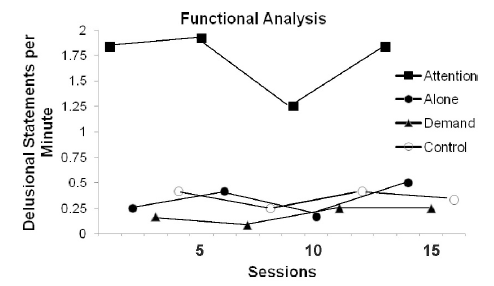
Instructions:
- Assign your group members one of the following roles: Client, therapist, director (who monitors and provides feedback to the other two performers and queries the audience)
- Act out the above functional analysis by conducting the procedures for each of the conditions at least once. Reproduce the same outcomes of the effect of the conditions on the client’s behavior as depicted in the above graph.
- What is the maintaining variable for the problem behavior?
- Given these results, design an intervention plan for this client.
A Case in the Classroom
Moore, J. W., & Edwards, R. P. (2003). An analysis of aversive stimuli in classroom demand contexts. Journal of Applied Behavior Analysis, 36, 339-348.
Client Description & Background: “Edgar was a 9-year-old boy who attended a general education fourth-grade classroom with 17 other students. Edgar had been referred for yelling in class. When he attended school in a different state the previous year, Edgar received a special education ruling of severely emotionally disturbed. Edgar’s academic and cognitive abilities fell in the average range of academic functioning, and he received 100% of his academic instruction in a general education classroom” (Moore & Edwards, 2003, p. 340).
“Edgar’s teacher was in her 6th year of teaching. She held a BS degree and an MA degree in elementary education” (Moore & Edwards, 2003, p. 340).
“Yelling was defined as vocal utterances above a normal tone of voice” (Moore & Edwards, 2003, p. 340).
“Task demands were defined as verbal instructions and written academic work delivered by the teacher” (Moore & Edwards, 2003, p. 340).
Procedure: Functional analysis was conducted using a multielement research design with the following conditions which were 10 min in duration.
- Demand condition: “The teacher presented learning trials to the student every 30 s throughout the session. All demans were presented in worksheet form. A sequential vocal, gestural, and physical (i.e., hand-over-hand) prompting hierarchy was employed to present demand trials. Hand-over-hand prompting included placing the pencil in the student’s hand and positioning the pencil lead on the worksheet. The teacher delivered praise if the student complied with the verbal or gestural prompt, continued the prompting sequence if the student did not comply, and terminated the trial (by removing the worksheet and moving to the other side of the room) if the student engaged in the target problem behavior at any time during the trial” (Moore & Edwards, 2003, p. 341).
- Attention condition: “The student was given access to several nonpreferred leisure activities throughout the session. The teacher ignored the child except to deliver attention in the form of a statement of disapproval or concern (e.g., ‘Stop that; you are disrupting the class’) and brief physical contact (e.g., a pat on the back or touching the arm) following each occurrence of the target problem behavior. All other appropriate and inappropriate behaviors were ignored” (Moore & Edwards, 2003, p. 341).
Results
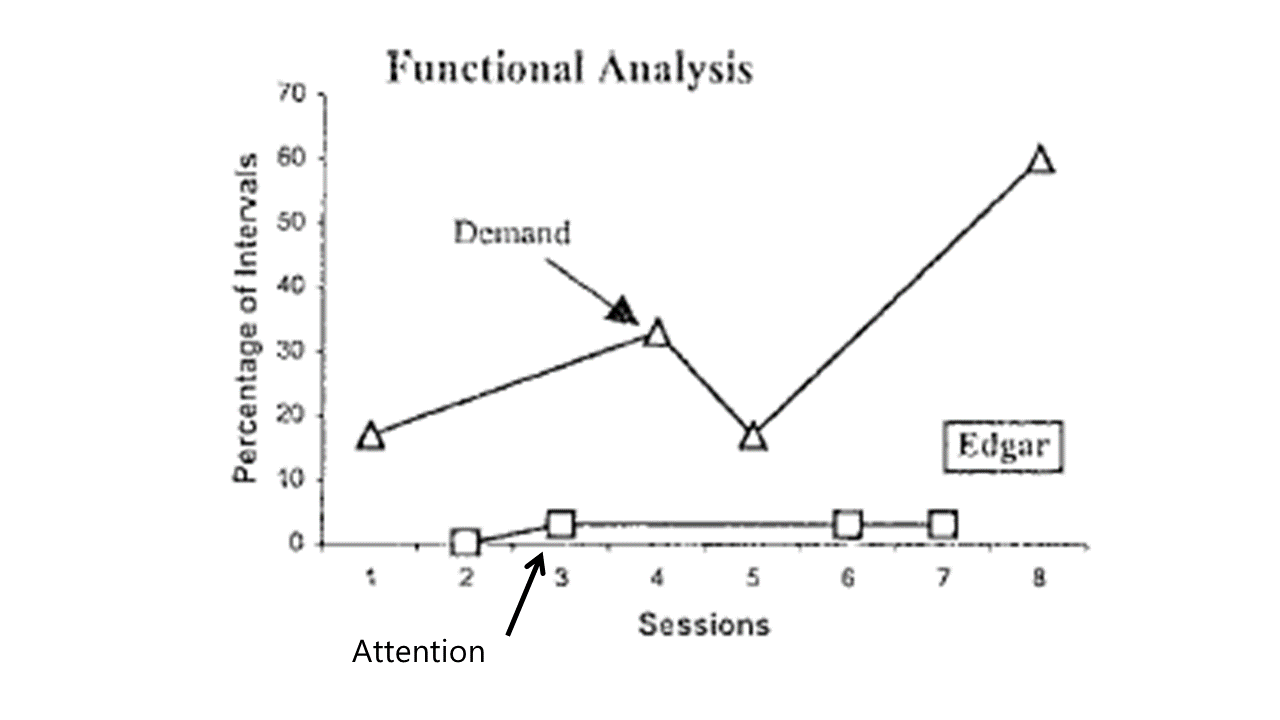
Instructions
- Assign your group members one of the following roles: Client, therapist, director (who monitors and provides feedback to the other two performers and queries the audience)
- Act out the above functional analysis by conducting the procedures for each of the conditions at least once. Reproduce the same outcomes of the effect of the conditions on the client’s behavior as depicted in the above graph.
- What is the maintaining variable for the problem behavior?
- Given these results, design an intervention plan for this client.
The Case of “You Already Said That!”
Rehfeldt and Chambers (2003). Functional analysis and treatment of verbal perseverations displayed by an adult with autism. JABA, 36, 259-261.
Client Description & Background: “Vince was a 23-year old man who had been diagnosed with autism and mild mental retardation. He also experienced seizures that were controlled medication” (Rehfeldt & Chambers, 2003, p. 259). Medications that Vince took included Phenytoin, Sertraline, Bisoprolol, and Trazedone. Vince attended a sheltered workshop on a daily basis and this is where the majority of his problem behavior was exhibited. When interacting with others, his conversation included perseveration on specific topics.
Perseverative speech was defined as Vince’s repeated comments. One occurrence of an utterance was distinguished from another of the same if there was no speech for at least 3 s. Common perseverative topics included talk about sirens, alarms, dentist or doctor appointments.
Procedure: Functional analysis was conducted using a multielement research design with the following conditions which were 10 min in duration.
- Attention condition: Following verbal perseverations 10 s of attention immediately was given by the therapist. This attention included both acknowledgment statements (e.g., “You sure do like those sirens, don’t you?”) and mild reprimands (e.g., “Don’t talk about sirens. There are none here.”).
- Demand condition: A work task such as filing or sorting paper was given to Vince. Following verbal perseveration, the task was immediately removed by the therapist for 30 s who looked away and did not interact with Vince. If an incorrect or no response occurred then the instruction was represented and the therapist modeled the correct behavior. If an incorrect or no response occurred to the level 1, then a level 2 prompt or physical assistance was provided for him to complete the correct response.
- Alone condition: Vince was in room alone. The therapist stood outside the door to observe and collect data on Vince’s behavior.
- Tangible condition: Immediately following verbal preservation Vince was provided with 30 s of access to preferred activities (writing about sirens, fire drills, etc.).
Results
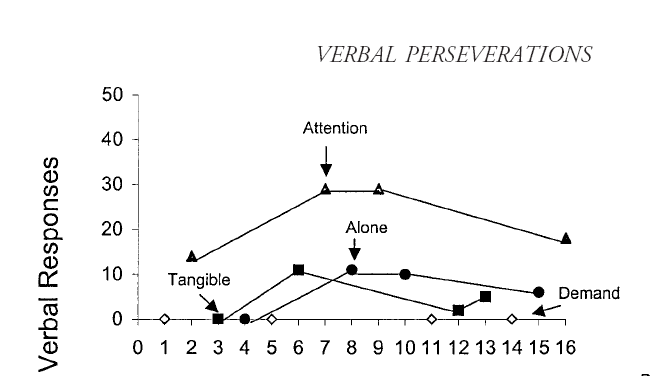
Instructions
- Assign your group members one of the following roles: Client, therapist, director (who monitors and provides feedback to the other two performers and queries the audience)
- Act out the above functional analysis by conducting the procedures for each of the conditions at least once. Reproduce the same outcomes of the effect of the conditions on the client’s behavior as depicted in the above graph.
- What is the maintaining variable for the problem behavior?
- Given these results, design an intervention plan for this client.
The Case of #@&*!
Dwyer-Moore and Dixon (2007). Functional analysis and treatment of problem behavior of elderly adults in long-term care. JABA, 40, 679-683.
Client Description & Background: “Carmen was an 89-year-old woman who had been diagnosed with vascular dementia with mood disturbance; referred for high rates of disruptive vocalization (e.g., obscenities)” (Dwyer-Moore & Dixon, 2007, p. 680). She lived in a large (159-bed) residential care facility.
Procedure: Functional analysis was conducted using a multielement research design with the following conditions which were 10 min in duration.
- Attention condition: “In the attention condition, the participant was told that the therapist had work to do and would be sitting across the room. No consequences were provided for any behavior other than the identified target behavior, which resulted in the experimenter approaching and providing approximately 5 to 10 s of social attention. Attention was similar to that noted from naturalistic observations of staff-resident interactions (e.g., ‘It’s OK, you’re fine,’ ‘Grandma, don’t say that,’ ‘Derek, tell me about the priesthood,’ ‘How are you doing today?’)” (Dwyer-Moore & Dixon, 2007, p. 680).
- Demand condition: “In the demand condition, the experimenter presented demands in the form of questions or gross motor tasks. Carmen was given demands such as clapping, raising their arms in the air, and knocking and lifting their legs these were similar to the gross motor tasks used in the facility’s occupational therapy program… Compliance resulted in approximately 3 to 5 s of praise and presentation of the next demand. No response or incorrect responses resulted in least-to-most prompts. Problem behavior resulted in removal of the demand for 30 s (Dwyer-Moore & Dixon, 2007, p. 680-681).
- Alone condition: “In the alone condition, the participant was alone in the family room while the experimenter observed unobtrusively through a 2.5 cm gap in the door. No social consequences were provided, and no leisure items were available” (Dwyer-Moore & Dixon, 2007, p. 681).
- Control condition: “In the control condition, various leisure items (e.g., magazines, puzzles, music, television) were continuously available. The experimenter also provided 5 to 10 s of social attention on a fixed-time (FT) 30-s schedule” (Dwyer-Moore & Dixon, 2007, p. 681).
Results
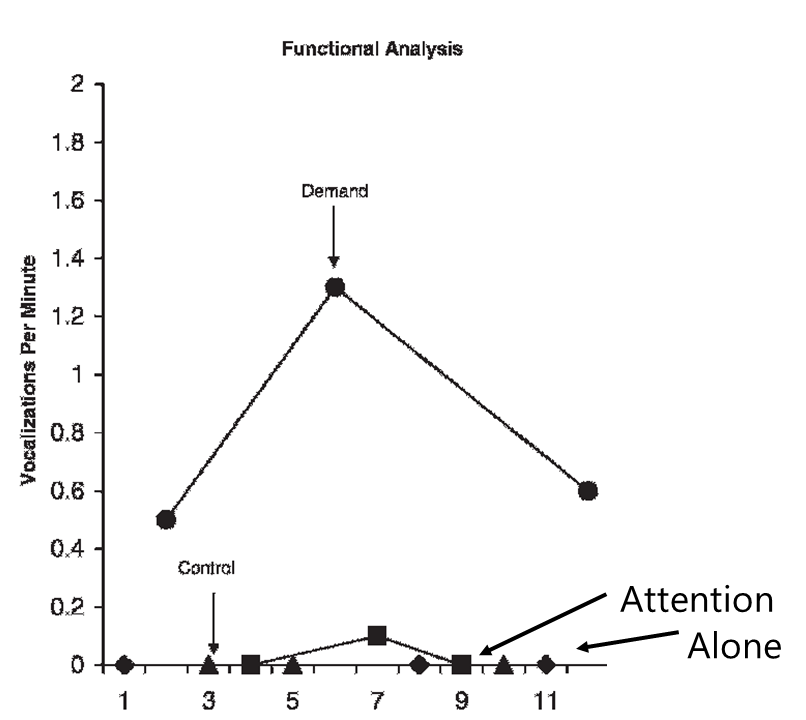
Instructions
- Assign your group members one of the following roles: Client, therapist, and director (who monitors and provides feedback to the other two performers)
- Act out the above functional analysis by conducting the procedures for each of the conditions at least once. Reproduce the same outcomes of the effect of the conditions on the client’s behavior as depicted in the above graph.
- What is the maintaining variable for the problem behavior?
- Given these results, design an intervention plan for this client.
The Case of Bye, Bye, I am Gone!
Lang, R., Davis, T., O’Reilly, M., Machalicek, W., Rispoli, M., Sigafoos, J., Lancioni, G., & Regester, A. (2010). Functional analysis and treatment of elopement across two school settings. Journal of Applied Behavior Analysis, 43, 113-118.
Client Description & Background: “Joe, a 4-year-old boy who had been diagnosed with Asperger syndrome participated,” (Lang et al., 2010, p. 114) runs out of the classroom 10-20 times per day, no matter the goings-on. John is in a regular classroom with 20 other children 2 teacher’s aides, and 1 teacher.
Problem Behavior: Elopement from the classroom. Define this behavior so that it can be measured and observed reliably.
Procedure: Functional analysis was conducted using a multielement research design with the following 5-min conditions:
- Attention condition: “The therapist sat next to Joe in her chair at the table, assumed the appearance of reading a notebook, and instructed him to play. Joe had free access to toys. If he eloped, the therapist retrieved him and provided verbal and physical attention, which continued for 5 s after the therapist had guided Joe back to the table” (Lang et al., 2010, p. 114).
- Escape condition: “The therapist delivered task demands based on Joe’s individualized education plan. If he did not respond to the demand within 5 s, the therapist provided a gestural or model prompt indicating the correct response. If he still did not respond, the therapist used a physical prompt. Following elopement, the therapist retrieved him using a minimal amount of physical contact (e.g., guiding lightly by the arm) and refrained from providing verbal attention. The therapist delayed presentation of the next demand for an additional 5 s once she returned Joe to the table” (Lang et al., 2010, p. 114-115).
- Tangible condition: “In the tangible condition, a television and DVD player, which the class used frequently, were present. The therapist played Joe’s preferred DVD for 10 s prior to the session, turned off the TV via remote control to start the session, and turned on the TV with the remote following elopement. After the TV was turned on, Joe would either return to the area or the therapist would retrieve him in the same manner as described for the escape condition” (Lang et al., 2010, p. 115).
- Play condition: “Joe had unrestricted access to toys. The therapist did not present task demands, maintained close proximity to Joe, provided verbal praise and physical contact about every 10 s, and ignored elopement” (Lang et al., 2010, p. 115).
Results
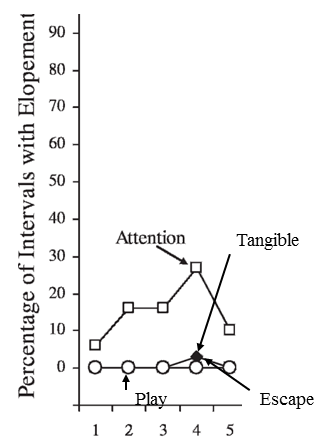
Note that 2 settings were another variable examined in this study, but for the purposes of demonstration and role play only 1 setting will be considered.
Instructions
- Assign your group members one of the following roles: Client, therapist, director (who monitors and provides feedback to the other two performers and queries the audience)
- Act out the above functional analysis by conducting the procedures for each of the conditions at least once. Reproduce the same outcomes of the effect of the conditions on the client’s behavior as depicted in the above graph.
- What is the maintaining variable for the problem behavior?
- Given these results, design an intervention plan for this client.
The Case of Hair Today, Gone Tomorrow
Rapp, J. T., Miltenberger, R. G., Galensky, T. L., Ellingson, S. A., & Long, E. S. (1999). A functional analysis of hair pulling. Journal of Applied Behavior Analysis, 32, 329-337.
Client Description & Background: “Kris was a 19-year-old female with severe mental retardation and mild cerebral palsy. She was able to ambulate, follow simple instructions, and communicate with single words. Due to a childhood stroke, Kris walked with a limp and could not open her left hand. Consequenctly, she pulled and manipulated her scalp hair with only her right hand. Her mother reported that Kris had pulled scalp hair since approximately age 3 and that the behavior would occasionally remit for periods up to a month. In the past, Kris’ hair pulling was unsuccessfully treated with Trazohone and parental scolding. According to her mother, Kris usually pulled scalp hair while watching television and in bed. After pulling a hair, she rolled it between her thumb and index finder, rubbed the hair on her lips, and then chewed on the hair while pulling it with her fingers. Her mother reported that periods of increased baldness seemed to be correlated with constipation, which may indicate that Kris was ingesting hairs. Kris did not appear to ingest hair during either phase of this investigation. Hair pulling produced an obvious area of baldness 5 cm in diameter on the top of her scalp” (Rapp et al., 1999, p. 331).
“Hair pulling was defined as any contact of the fingers of her right hand with her scalp. Hair manipulation was defined as rolling of pulled hair between any fingers, gazing at pulled hair, and any contact of hair with the lips or mouth. Hair manipulation onset always occurred within 3 s of hair pullong offset” (Rapp et al., 1999, p. 331).
Procedure: Functional analysis was conducted using a multielement research design with the following conditions:
- Attention condition: Kris and a therapist were seated side by side in the room. Kris was given a video to watch on the television while the therapist shuffled papers and wrote in a notebook. No interaction took place between them unless Kriss pulled hair. Contingent on hair pulling, the therapist reached over and gently pressed Kris’ arm down from her head and provided disapproving statements (e.g., ‘Don’t pull your hair’)” (Rapp et al., 1999, p. 332).
- Demand condition: “During this condition, a therapist stood behind Kris, who was seated at a large table. The therapist presented a task (from her prevocational curriculum) that involved taking single pieces of different colored paper off 4 piles in a sequential order and placing the collated papers into a specified envelope. Kris was shown the correct sequence for the papers and then prompted every 20 to 30 s in a 3-step sequence (verbal prompt; verbal prompt and pointing; verbal prompt, pointing, plus manual guidance) to stack the papers accordingly. Praise was provided for 2 to 3 s contingent upon completing the correct paper sequence and filling the envelope. If hair pulling occurred, the therapist removed the materials and suspended all interactions with Kris for 30 s” (Rapp et al., 1999, p. 332).
- “Kris was seated alone in the observation room to watch a video on the television” (Rapp et al., 1999, p. 332).
- Control condition: “Kris was seated across from a therapist in the research room and was given continuous access to toys that her mother identified as being preferred. Therapist praise and pats to Kris’ arm were provided at least once every 10 s, and there were no social consequences for hair pulling” (Rapp et al., 1999, p. 332).
Results

Instructions
- Assign your group members one of the following roles: Client, therapist, director (who monitors and provides feedback to the other two performers and queries the audience)
- Act out the above functional analysis by conducting the procedures for each of the conditions at least once. Reproduce the same outcomes of the effect of the conditions on the client’s behavior as depicted in the above graph.
- What is the maintaining variable for the problem behavior?
- Given these results, design an intervention plan for this client.
Discussion Questions
- Which FAn condition was most difficult to perform? Why? How can performing that condition be made easier?
- How would you teach someone to implement treatment procedures?
- What would you do if the treatment procedure based on a FAn was ineffective?

